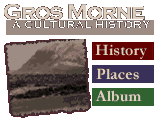

The next chapter in the history of this area belongs to that of the Europeans. The first Europeans to arrive in North America were the Norse or Vikings, some 500 years before the arrival of John Cabot. Proof of their existence on the island of Newfoundland comes from the remains of a boat repair station found at L'anse aux Meadows, on the northernmost tip of the island. Whether the Norse had a permanent settlement in the park area is unknown.
An Italian exporer, Giovanni Caboto (John Cabot) is generally credited with the the discovery of Newfoundland in 1497. He discovered Newfoundland as a mistake, he was attempting to find a western route to the Orient for King Henry VII of England. The marine resources off Newfoundland impressed the Europeans, and many countries sent ships every year to exploit these resources.
The Frenchman, Jacques Cartier landed at Cow Head on June 16, 1534. This began Europe's interest in the West Coast. The French Basque whalers were the first Europeans to take advantage of the West Coast. With their headquarters in Butus in southern Labrador(now Red Bay), the Basque caught whales, the whale oil being used for lantern fuel back in Europe. By the 1590's, with a decline in whale populations, the Basque also caught cod and seals.
In 1583, Sir Humphrey Gilbert claimed Newfoundland as Britain's first colony for Queen Elizabeth I. Arguments between Britain and France lasted for years, as both wanted to use the resources of the Gulf of St. Lawrence and the island of Newfoundland. This lead to the development of the French Shore.
Under the Treaty of Utrecht (1713), France lost its claim to Newfoundland, but were allowed to fish along parts of the coast between Cape Bonavista and Point Riche. The French were not allowed to settle in this area, however, they were permitted to land and dry their catch onshore. In 1763, the Treaty of Paris prevented Britain's subjects from settling on this shore. The park area came under the provisions of the Treaty of Versailles in 1783, when the French shore was extended from Cape St. John to Cape Ray. It was illegal to settle the area according to the treaty. This was generally ignored, with settlement taking a hold around the turn of the 19th century.
| << previous | next >> |